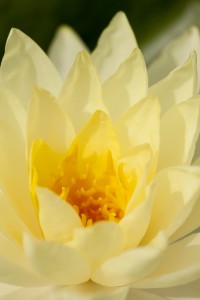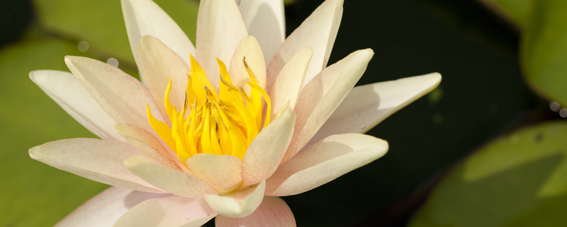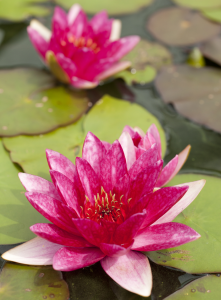Wondrous Water Lilies
Posted in Gardening Tips on August 6 2013, by Sonia Uyterhoeven
Sonia Uyterhoeven is the NYBG‘s Gardener for Public Education

Last weekend I spent my Saturday and Sunday in the Enid A. Haupt Conservatory teaching water lilies. We have two pools located in the side courtyards of the Conservatory. The pool on the right contains hardy water lilies while the pool on the left contains tropical water lilies. These pools mirror the structure inside the Conservatory, where the temperate houses are on the right and the tropical houses are located on the left.
The concrete pools are surrounded by glazed bricks, and the interior mechanics are made up of more bricks and cinderblocks used to elevate the water lily containers. A pump oxygenates the water and maintains a slight circulation to help deter mosquitoes, while the koi join in to help keep the water features bug free.
Water lilies prefer their pots to be wide rather than deep to accommodate maximum growth. Containers specifically designed for water lilies are generally 12-20 inches in diameter and 8-10 inches deep, as the size of the pot can have an influence on the size of the water lily. A smaller pot will restrict the growth of the water lily (in small pond situations this might be an asset) and a larger pot will give it more space to grow.
When planting water lilies, DO NOT grab for your favorite blend of potting mix. Potting soils tend to be high in perlite, vermiculite, and peat—all of these are too buoyant and will just end up floating out of the pot and making a mess in your water feature. The peat will also alter the pH and make things too acidic. Loam or a clay-loam soil is best for potting up your water lilies. And don’t over complicate it: for most of us it means digging some soil from our gardens vs. reaching for a bag of potting soil.
Cover the holes in the container with mesh (an old screen will work), newspaper, or burlap, so that the soil doesn’t escape into the pond. Fill the container 2/3 of the way with damp garden soil. For hardy water lilies you place the rhizome so that the growing point (the eye) is facing the center of the pot. Plant at a slight angle and cover the lower portion of the rhizome, leaving the eye rising just slightly above the soil line. The rhizome is positioned in this fashion so that it can spread across the pot as it grows.

Once planted, cover the exposed soil with about a 1/2-inch of pea gravel or sand. Tropical water lilies grow from tuber-like storage systems and should be planted in the center of the pot with the growing point raised slightly above the soil surface.
Water lilies can be submerged 6-18 inches deep. It is best to lower the container gradually in the water as the water lily begins to grow, something easily accomplished by raising the container on bricks and gradually removing the bricks over time. Be aware that initial depth can influence growth, however. One year, the staff at the Conservatory decided to do an experiment and dropped the newly potted water lilies down to 18 inches. It takes an enormous amount of energy for the plants to emerge and reach sunlight from that depth, and more than half of them never came up to the surface.

Water lilies need a minimum of 6 hours of sunlight to look their best and flower prolifically. We fertilize our water lilies with aquatic fertilizer tablets at planting time and then once a month up until September. Just press the tablets into the soil and cover them over with the soil and gravel.
Next week I will discuss the raison d’être for going through all this work to grow water lilies—the flowers—and give you a glimpse into some of the wondrous water lilies that we have growing in our pools. This will be just in time for you to come and select your favorite while you attend our next Cocktail Evening and Summer Concert, which takes place on Thursday, August 15, from 6-9pm.


When will the amazon water lily bloom?